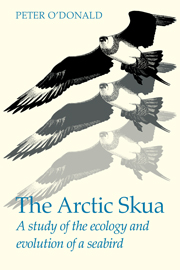Book contents
- Frontmatter
- Contents
- List of figures
- List of tables
- Preface
- 1 The Arctic Skuas of Fair Isle
- 2 Numbers and distribution
- 3 Feeding behaviour and ecology
- 4 Breeding ecology
- 5 Genetics
- 6 Demography and selection
- 7 Sexual behaviour
- 8 Sexual selection
- 9 Genetic models of sexual selection in birds
- 10 Mating preferences of the Arctic Skua
- 11 Conclusions
- Appendix A Rates of increase of bird populations
- Appendix B Analysis of variance of a 2 × r table with unequal numbers of observations
- Appendix C Statistical analysis of assortative and disassortative mating in polymorphic birds
- References
- Index
8 - Sexual selection
Published online by Cambridge University Press: 21 May 2010
- Frontmatter
- Contents
- List of figures
- List of tables
- Preface
- 1 The Arctic Skuas of Fair Isle
- 2 Numbers and distribution
- 3 Feeding behaviour and ecology
- 4 Breeding ecology
- 5 Genetics
- 6 Demography and selection
- 7 Sexual behaviour
- 8 Sexual selection
- 9 Genetic models of sexual selection in birds
- 10 Mating preferences of the Arctic Skua
- 11 Conclusions
- Appendix A Rates of increase of bird populations
- Appendix B Analysis of variance of a 2 × r table with unequal numbers of observations
- Appendix C Statistical analysis of assortative and disassortative mating in polymorphic birds
- References
- Index
Summary
Darwin's theory of sexual selection
Sexual selection occurs when some individuals are more successful in finding mates than others. Like other characteristics of animals, sexual behaviour varies. Some males will defend their territories more fiercely than others, or court the females more vigorously, or display more attractive plumage. These characteristics will be selected if they increase the chances of mating. This is sexual selection as Darwin defined it in The Origin of Species:
This depends, not on a struggle for existence, but on a struggle between the males for possession of the females; the result is not death to the unsuccessful competitor, but few or no offspring. Sexual selection is, therefore, less rigorous than natural selection. Generally, the most vigorous males, those which are best fitted for their places in nature, will leave most progeny. But in many cases, victory depends not on general vigour, but on having special weapons, confined to the male sex. A hornless stag or spurless cock would have a poor chance of leaving offspring’.
And Darwin thought that sexual selection would be the cause of the evolution of many of the differences in structure and coloration of the sexes:
‘Thus it is, as I believe, that when the males and females of any animal have the same general habits of life, but differ in structure, colour, or ornament, such differences have been mainly caused by sexual selection; that is, individual males have had, in successive generations, some slight advantage over other males, in their weapons, means of defence, or charms; and have transmitted these advantages to their male offspring’.
- Type
- Chapter
- Information
- The Arctic SkuaA study of the ecology and evolution of a seabird, pp. 180 - 209Publisher: Cambridge University PressPrint publication year: 1983



